Guitar Chalk Sessions: Modding Simple Chords Part 2 (E, A and B)

Disclaimer: The context of this lesson is beginner to early intermediate. If it seems too easy or obvious to you, please be aware that it may simply not apply to your skill level.
Part One, where we cover G, C and D chords is not a prerequisite to this article.
Check out Part One if you want to run through those chords and a little preamble. Otherwise, this lesson can be understood on its own.
Once more, we’re going to mod our chords to make them easier to play. You might say we’re covering the basics of chord variation, covering what’s necessary to help a beginner guitarist get started on the topic.
We’ll take a closer look at the E, A and B chords individually and tab them out in ways that make them easier to play. As a result we’ll conclude this lesson armed with alternate chord patterns that are easier and more functional than what you might be used to playing.
Basically, we’re going to break these chords down into smaller, more manageable, components.

Making guitar chords easier, one note at a time.
A lot of guitar players never deviate from the way they first learned how to play a chord.
In this lesson, we’re going to get intentional about deviating and coming up with some new options.
Let’s start with the E major chord.
Mod #1: Open E Major
Handling the E major chord (the formal version) can generally be done without much difficulty. No muted notes are required and there’s little stretching involved.
Specifically, the formal version gives us a six-note sequence with three root notes (three E notes separated by three octaves), a major 3rd interval and two perfect fifths.
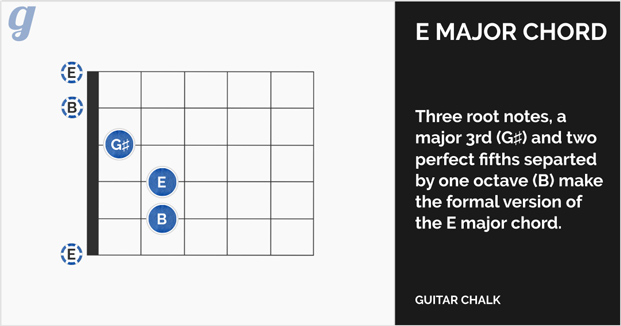
For reference, Guitar Tricks has some great HTML 5 E chord diagrams along with a number of other variations. Those diagrams are free, though you can checkout our Guitar Tricks review of the paid membership as well.
One of my favorite ways to change this shape is to simply move the pattern up to the seventh fret.
From there, we can continue to use the root E from the open sixth string and then strum the octave E (at the seventh fret) with the A♭(3rd of the chord) at the sixth fret.
Here’s a chart for the seventh fret mod:
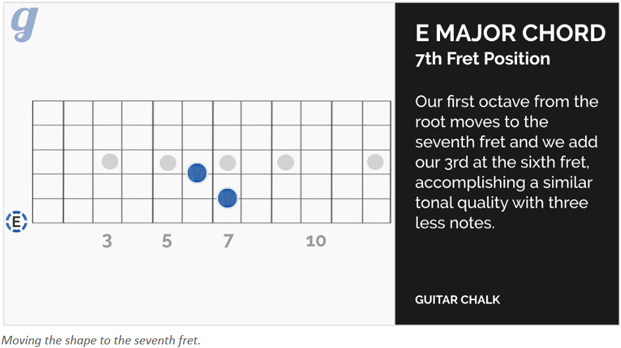
Note that in this shape you only need two fingers to play the chord, since you’re still taking advantage of the low open E.
The primary advantage is that you’re using three less notes.
Additional I would cite the following benefits:
Reason #1: For use in a power chord progression.
Not only is it easier to play the three-note sequence at the seventh fret but, it’s far more practical and better-suited if you’re trying to fill out a power chord progression. You’re getting the two low E notes and then the major quality of the chord from the interval on the sixth fret.
Reason #2: When there’s a need to compartmentalize the chord.
Let’s say for example you want to fingerpick through a chord and leave the higher notes (from the three highest strings) free for some kind of melodic improvisation. Being able to quickly access notes on the higher register is more easily done in the modded variation of the chord we showed you, than it is in the original.
Reason #3: You don’t always need a saturated chord.
Once guitar players get into the process of playing songs and actually composing music, they’ll find that open chords with every note included is not always necessary. Sometimes you need to utilize a “lean” version of a chord instead of one with three different octaves of the same note.
Keep in mind, you only need two notes to form a chord. If you have a root note and you add your major (or minor) interval than that’s all you need to form the chord’s basic tone.

In power chord progressions where you’re not worried about the chord’s specific tonality, you can even omit the 3rd interval and just play the two octaves.
The more you can break down each chord, the more flexible and quick you’ll be when it comes to making chord changes. In the case of these chords, it’s a matter of improving flexibility and functionality as opposed to simply adding another voicing, especially since the voicings of the two E chords we’ve just looked at don’t sound drastically different.
But, one is easier to play than the other and more optimal for certain situations.
Let’s cover the A chord.
Mod #2: Open A Major
There are a couple different voicings we can roll out for our A chord mod.
First, let’s look at the voicing that you’re likely to see in a formal classroom.

I never liked this shape because it felt like I had to awkwardly stuff three fingers in next to each other in order to grab those notes.
The easiest alternative is to leave off the C♯ note on the second string and allow that to become an open B.
Here’s the tab:

We’ve omitted the C♯ and now have a chord that can be played with only two fingers and no need for barring. The result is a more resonant, open chord that rings distinctly with the high E and B notes and gives you extra sustain.
Our second voicing mimics the approach we took with the E chord where we moved our shape up to the seventh fret and simply added the third of the root.
Once again, we’ll use a tab sheet to illustrate.

We have the octave of the root (A) and the 3rd of the root (C♯).
The high B and E strings, which I’ve left open as part of the chord, can be used or not used according to preference. Their impact on the chord’s voicing isn’t significant.
We’ve handled both the E and A chords similarly. The B chord mods are going to take a little bit of a different route, since the formal shape of a B is so different from E and A. This chord is tough. From the basic B major all the way to B7 chord forms, it’ll give beginners fits.
We’ll give you a couple ways to mod and simplify the shape for both a B minor and major.
No fits necessary.
Mod #3: Open B Major/Minor
In most cases we use a barre form to play either B major or minor chords.
Something like this (arpeggiated):
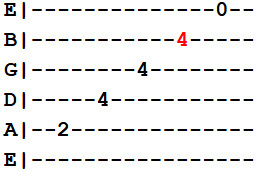
This is the arpeggiated version of a conventional B major chord. To make the same shape a minor, simply drop the third of the chord (highlighted in red) down one semitone.
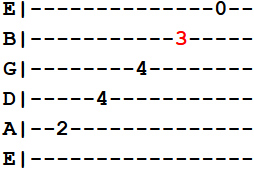
This can be a bit of a challenging shape for beginners who haven’t tried to tackle the barre or power chord guitar shapes yet.
Not that it’s a bad idea to learn barre chords but, if you don’t want to tackle that in the middle of learning open chords, here are a few ways to break down the shape.
First, let’s look at the notes in the B minor scale to see if there are any open notes we can easily incorporate into our chord:
B, C♯, D, E, F♯, G, and A
We can easily use the open G to build our B chord this way:

Here’s a chord diagram with an explanation:
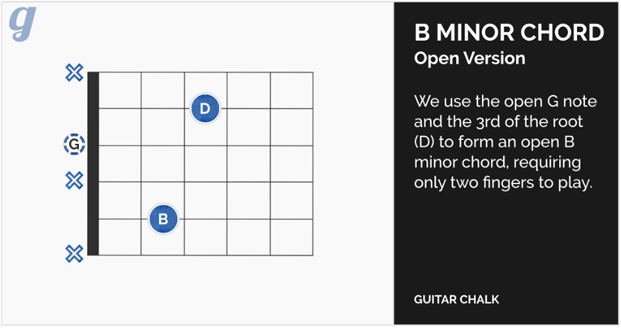
This shape allows you to play a B minor chord using the same form that you’re used to from the other open chords you’ve already learned.
It’s an easy shape to learn that has some nice resonance with the open G note and saves you from having to trudge through power chord shapes until you’re good and ready.
But, what about B major?
There’s a way to mod that one as well.
We’re simply going to play the barre chord version without the two lowest notes.
Here’s what the chord diagram looks like:
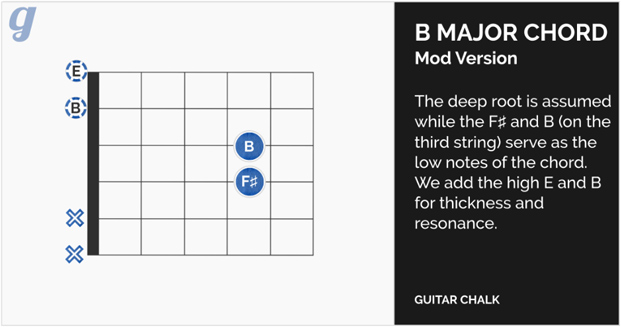
If we look at the pitches of the B major scale, you get the following notes: B, C♯, D♯, E, F♯, G♯ and A♯
You can see from our diagram that we’ve used F♯, B and E, drawing our chord exclusively from the B major scale.
And, once again, we only need two fingers to play the chord.
Conclude
Between parts one and two you’ve got six chords that have been paired down to their most basic and easy-to-play components.
If you have questions about the content, feel free to leave it in the comments section or get in touch with me directly via the content information below.
Bobby Kittleberger is the editor of Guitar Chalk and a staff writer at Guitar Tricks. You can get in touch with him here or via Twitter and Facebook.
Flickr Commons Image Courtesy of Kmeron
Get The Pick Newsletter
All the latest guitar news, interviews, lessons, reviews, deals and more, direct to your inbox!
Bobby is the founder of Guitar Chalk, and responsible for developing most of its content. He has worked with leading guitar industry companies including Sweetwater, Ultimate Guitar, Seymour Duncan, PRS, and many others.
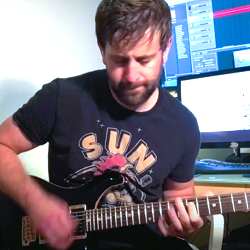







![Joe Bonamassa [left] wears a deep blue suit and polka-dotted shirt and plays his green refin Strat; the late Irish blues legend Rory Gallagher [right] screams and inflicts some punishment on his heavily worn number one Stratocaster.](https://cdn.mos.cms.futurecdn.net/cw28h7UBcTVfTLs7p7eiLe.jpg)


